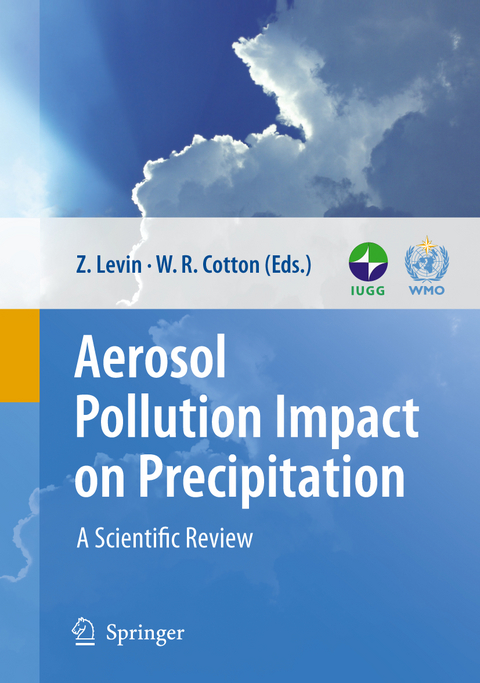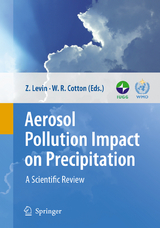Aerosol Pollution Impact on Precipitation
A Scientific Review
Seiten
2008
Springer-Verlag New York Inc.
978-1-4020-8689-2 (ISBN)
Springer-Verlag New York Inc.
978-1-4020-8689-2 (ISBN)
This book reviews current knowledge on the relationship between aerosols and precipitation reaching the Earth's surface. It includes a list of recommendations that could help to farther advance knowledge in this area.
Life on Earth is critically dependent upon the continuous cycling of water between oceans, continents and the atmosphere. Precipitation (including rain, snow, and hail) is the primary mechanism for transporting water from the atmosphere back to the Earth’s surface. It is also the key physical process that links aspects of climate, weather, and the global hydrological cycle. Changes in precipitation regimes and the frequency of extreme weather events, such as floods, droughts, severe ice/snow storms, monsoon fluctuations and hurricanes are of great potential importance to life on the planet. One of the factors that could contribute to precipitation modification is aerosol pollution from various sources such as urban air pollution and biomass burning. Natural and anthropogenic changes in atmospheric aerosols might have important implications for precipitation by influencing the hydrological cycle, which in turn could feed back to climate changes.
From an Earth Science perspective, a key question is how changes expected in climate will translate into changes in the hydrological cycle, and what trends may be expected in the future. We require a much better understanding and hence predictive capability of the moisture and energy storages and exchanges among the Earth’s atmosphere, oceans, continents and biological systems. This book is a review of our knowledge of the relationship between aerosols and precipitation reaching the Earth's surface and it includes a list of recommendations that could help to advance our knowledge in this area.
Life on Earth is critically dependent upon the continuous cycling of water between oceans, continents and the atmosphere. Precipitation (including rain, snow, and hail) is the primary mechanism for transporting water from the atmosphere back to the Earth’s surface. It is also the key physical process that links aspects of climate, weather, and the global hydrological cycle. Changes in precipitation regimes and the frequency of extreme weather events, such as floods, droughts, severe ice/snow storms, monsoon fluctuations and hurricanes are of great potential importance to life on the planet. One of the factors that could contribute to precipitation modification is aerosol pollution from various sources such as urban air pollution and biomass burning. Natural and anthropogenic changes in atmospheric aerosols might have important implications for precipitation by influencing the hydrological cycle, which in turn could feed back to climate changes.
From an Earth Science perspective, a key question is how changes expected in climate will translate into changes in the hydrological cycle, and what trends may be expected in the future. We require a much better understanding and hence predictive capability of the moisture and energy storages and exchanges among the Earth’s atmosphere, oceans, continents and biological systems. This book is a review of our knowledge of the relationship between aerosols and precipitation reaching the Earth's surface and it includes a list of recommendations that could help to advance our knowledge in this area.
Principles of Cloud and Precipitation Formation.- Sources and Nature of Atmospheric Aerosols.- The Distribution of Atmospheric Aerosols: Transport, Transformation and Removal.- In Situ and Remote Sensing Techniques for Measuring Aerosols, Clouds and Precipitation.- Effects of Pollution and Biomass Aerosols on Clouds and Precipitation: Observational Studies.- Effects of Pollution Aerosol and Biomass Burning on Clouds and Precipitation: Numerical Modeling Studies.- Parallels and Contrasts Between Deliberate Cloud Seeding and Aerosol Pollution Effects.- Summary.- Recommendations.
| Zusatzinfo | 71 Illustrations, color; 37 Illustrations, black and white; XXI, 386 p. 108 illus., 71 illus. in color. |
|---|---|
| Verlagsort | New York, NY |
| Sprache | englisch |
| Maße | 155 x 235 mm |
| Themenwelt | Naturwissenschaften ► Biologie ► Ökologie / Naturschutz |
| Naturwissenschaften ► Geowissenschaften ► Geologie | |
| Naturwissenschaften ► Geowissenschaften ► Meteorologie / Klimatologie | |
| ISBN-10 | 1-4020-8689-X / 140208689X |
| ISBN-13 | 978-1-4020-8689-2 / 9781402086892 |
| Zustand | Neuware |
| Haben Sie eine Frage zum Produkt? |
Mehr entdecken
aus dem Bereich
aus dem Bereich




